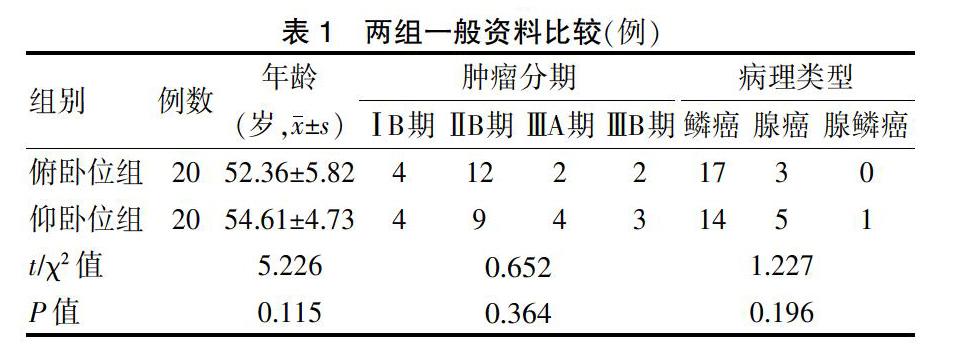宫颈癌调强放疗俯卧位Bellyboard与仰卧位的剂量学与副反应比较
2020-11-06周龙唐滟刘耿淳
周龙 唐滟 刘耿淳


[摘要] 目的 通過比较宫颈癌调强放疗俯卧位+有孔定位装置(Belly board)与仰卧位照射中肠袋、膀胱、直肠、股骨头剂量-体积关系及急性放射性肠炎的发生情况,探讨宫颈癌理想的放疗体位。 方法 随机选取2017年6月—2019年3月在湖南省湘潭市中心医院行调强放疗宫颈癌患者40例,先后俯卧位Belly board与仰卧位CT扫描,在相同条件下勾画靶区及危及器官并进行治疗计划优化,比较两种体位下靶区和危及器官的剂量-体积关系。再将患者根据年龄和分期进行分层抽样和随机数字法分为俯卧位组(20例)和仰卧位组(20例)实施治疗,观察两组急性放射性肠炎发生情况。 结果 与仰卧位组比较,俯卧位组危及器官肠袋体积明显减少(P < 0.05),膀胱和直肠平均体积、靶区平均体积比较,差异无统计学意义(P > 0.05),靶区适形度指数和均匀性指数比较,差异无统计学意义(P > 0.05)。俯卧位组肠袋接受25~45 Gy剂量的体积较仰卧位组明显减少(P < 0.01),其他危及器官剂量-体积关系比较,差异无统计学意义(P > 0.05)。俯卧位组较仰卧位组急性放射性肠炎的发生率明显降低,严重程度减轻,差异有统计学意义(P < 0.05)。 结论 宫颈癌调强放疗,采用俯卧位Belly board能明显降低肠袋剂量,减轻肠道副反应的发生。
[关键词] 宫颈癌;有孔定位装置;调强放疗;体位
[中图分类号] R737.9 [文献标识码] A [文章编号] 1673-7210(2020)09(b)-0086-05
[Abstract] Objective To explore the optimal position in radiotherapy for cervical cancer, by comparing the dose-volume relationship of the mid-intestinal pouch, bladder, rectum, femoral head and the occurrence of acute radiation enteritis in the prone position + Belly board and the supine position. Methods A total of 40 patients with cervical cancer who underwent intensity modulation radiotherapy in Xiangtan Central Hospital, Hu′nan Province from June 2017 to March 2019 were randomly selected. CT scans were performed in Belly board and Belly position respectively. The target area and organs at risk were mapped under the same conditions and the treatment plan was optimized to compare the dose-volume relationship between the target area and organs at risk in two positions. Then the patients were divided into prone position group (20 cases) and supine position group (20 cases) for treatment by stratified sampling and random number table method according to age and stage, and the occurrence of acute radiation enteritis was observed in the two groups. Results Compared with the supine position group, the volume of intestinal pouch of organs at risk in the prone position group was significantly reduced (P < 0.05), the average volume of bladder and rectum and the average volume of target area showed no statistical significance (P > 0.05), and the comparison of target area fitness index and uniformity index showed no statistical significance (P > 0.05). Compared with the supine group, the volume of intestinal pouch receiving 25-45 Gy dose was significantly reduced in the prone position group (P < 0.01), while the dose-volume relationship of other organs at risk was not statistically significant (P > 0.05). The incidence of acute radiation enteritis in prone position group was significantly lower than that in supine position group, and the severity was reduced, with statistically significant difference (P < 0.05). Conclusion For intensity-modulated radiotherapy of cervical cancer, the Belly board in prone position can significantly reduce the dose of intestinal pouch and reduce the occurrence of intestinal side effects.
[Key words] Cervical cancer; Belly board; Intensity-modulated radiation therapy; Position
调强放疗已经成为各期宫颈癌的主要治疗方式,特别是ⅡB期以上中晚期宫颈癌,同步放化疗为标准治疗模式,宫颈癌的调强放疗目前已经对临床靶区和危及器官勾画达成了共识[1-2],但放疗的体位没有形成共识,常用的体位包括仰卧位和俯卧位,哪种体位在保证靶区剂量的同时能最大限度降低危及器官的剂量,减轻放疗副反应,仍值得研究。本研究随机选取湖南省湘潭市中心医院(以下简称“我院”)40例调强放疗的宫颈癌患者,先后在相同条件下采用俯卧位+有孔定位装置(Belly board)与仰卧位进行CT扫描,在相同条件下勾画靶区及危及器官并进行治疗计划优化,比较两种体位下靶区及肠袋、膀胱、直肠、股骨头、骨髓剂量-体积关系及急性放射性肠炎的发生情况,探讨宫颈癌理想的放疗体位。
1 资料与方法
1.1 一般资料
本研究经我院医学伦理委员会批准,所有患者均知情且签署同意书。随机选取2017年6月—2019年3月在我院放疗科行调强放疗的宫颈癌患者 40例,每例患者先后采用俯卧位Belly board和仰卧位定位固定,定位前喝水充盈膀胱。俯卧位组使用科莱瑞迪公司俯卧位盆腔专用固定装置,该装置为碳纤维底座上置高密度泡沫,泡沫上有边长29 cm的有孔定位装置Belly board,每例患者以相同的方式俯卧于Belly board固定架,使下腹部俯于Belly board腹孔上,仰卧位组使用科莱瑞迪公司碳纤维平板固定架。两种体位都使用热塑体膜固定。每例患者先后进行俯卧位和仰卧位CT增强扫描,两次扫描间隔时间不超过5 min。
1.2 靶区勾画、治疗计划优化与剂量-体积关系比较
由同一个医生对同一个患者两种体位下的靶区及危及器官进行勾画,临床靶区(CTV)勾画按Lim等[3]推荐的宫颈癌CTV勾画共识,危及器官(OAR)勾画按Gay等[4]推荐的OAR勾画共识,肠袋包括全部的小肠、大肠,除去直肠和肛门,范围包括PTV(计划靶区)上下各1 cm。由同一个物理师对同一个患者两种体位分别行静态调强优化,全部采用Pinnacle 39.6治疗计划系统,7个照射野,靶区处方剂量:PGTV(肿瘤靶区)50 Gy/25次,PTV45 Gy/25次,治疗计划要求PGTV、PTV≥95%处方剂量,危及器官剂量统一限制。统计俯卧位组与仰卧位组的靶区及危及器官的剂量-体积关系。
1.3 治疗分组与副反应观察
将40例患者根据年龄和肿瘤分期进行分层随机化分组,采用分层抽样和随机数字表法分为俯卧位组和仰卧位组,每组20例。两组年龄、肿瘤分期、病理类型比较,差异无统计学意义(P > 0.05)。见表1。40例患者均接受同期放化疗,放疗按上述治疗计划实施,同步化疗方案为单药顺铂(80 mg/m2,化疗疗程21 d),外照射结束再后装治疗,用Ir-192高剂量率后装治疗机,采用宫腔、阴道3管施源器,A点剂量为600 cGy/次,共5次,每周2~3次。俯卧位组所有患者按计划完成全部治疗,仰卧位组有2例因为腹泻副反应取消了第2次同步化疗。统计两组急性放射性肠炎的发生情况,急性放射性肠炎诊断与分级依据RTOG急性放射损伤分级标准进行[5]。
1.4 统计学方法
采用SPSS 16.0统计软件进行数据分析,计量资料以均数±标准差(x±s)表示,组间比较采用配对t检验;计数资料以例数或百分率表示,采用χ2检验。以P < 0.05为差异有统计学意义。
2 结果
2.1 兩组体位下危及器官体积、靶区体积及靶区适形度指数、靶区均匀性指数比较
俯卧位组肠袋体积明显低于仰卧位组(P = 0.006);两组直肠平均体积、膀胱平均体积、靶区平均体积比较,差异无统计学意义(P > 0.05);两组PTV适形度指数和均匀性指数比较,差异无统计学意义(P > 0.05)。见表2。
2.2 两组危及器官剂量-体积关系
俯卧位组与仰卧位组比较,肠袋接受5~50 Gy剂量的体积均有减少,其中接受25~45 Gy剂量的体积减少差异有统计学意义(P < 0.01),其他危及器官剂量-体积关系两组间比较,差异无统计学意义(P > 0.05)。见表3~6。
2.3 急性放射性肠炎的发生率与严重程度比较
俯卧位组发生急性放射性肠炎10例(50%),仰卧位组发生16例(80%),两组急性放射性肠炎发生率比较,差异有统计学意义(χ2 = 3.956,P = 0.047);俯卧位组发生急性放射性肠炎1级5例,2级5例,仰卧位组发生1级3例,2级11例,3级2例,两组急性放射性肠炎严重程度比较,差异有统计学意义(t = 16.602,P = 0.001)。
3 讨论
宫颈癌各期放射治疗的5年生存率国内外报道都在54%以上,中国医学科学院肿瘤医院报道为68.7%,如何降低危及器官照射剂量、减轻治疗副反应,显得越来越重要,放射性肠道损伤是宫颈癌放射治疗最常见的副反应,目前国内外已开展一些减少放射性肠道损伤的研究,包括膀胱充盈技术、排空直肠技术、图像引导放疗技术、俯卧位技术等[6-12]。通过特殊的治疗体位来降低肠道照射剂量和体积是预防放射性肠道损伤较好的方法。
应用俯卧位Belly board装置已经证明可以减少直肠癌患者放射性肠道损伤,已被多个共识指南推荐于直肠癌放疗[13-17]。宫颈癌放疗患者应用俯卧位Belly board装置的研究一直在进行。Pinkawa等[18]研究显示俯卧位能减少宫颈癌调强放疗肠道副作用。Adli等[19]研究显示宫颈癌患者俯卧位比仰卧位在靶区剂量25~50 Gy时小肠的受照体积从19%下降到12.5%(P = 0.005)。Joseph 等[20]报道了32例妇科肿瘤患者的研究结果,应用俯卧位放疗能减少小肠≥100%,95%,90%和85%的处方剂量体积,俯卧位下发生放射性肠炎副反应的程度低于仰卧位。Kris等[21]观察21例宫颈癌放疗患者,发现俯卧位可以减少后位方向小肠的体积。Anjanappa等[22]研究显示,俯卧位在减少肠道副反应的同时,可能增加系统误差和随机误差。上述研究的结论基本是一致的,宫颈癌俯卧位放疗可能减少放射性肠道损伤,也可能存在体位重复性差,增加摆位误差的问题,这些研究也存在如下问题:研究报道较少,多是些小样本报道;对比研究中多没有对两种体位靶区的勾画及治疗计划的一致性进行比较,不能排除靶区勾画及治疗计划的差异对肠道剂量学产生影响;部分研究只是单纯的俯卧位,没有采用有孔定位装置Belly board;所以,目前对宫颈癌的放疗体位没有共识推荐。
本研究总病例数达到40例,设计上保证了两种体位下靶区及危及器官勾画和治疗计划的一致性,结果可见两种体位勾画的GTV、CTV、直肠、膀胱平均体积没有差异(P > 0.05),靶区PTV适形度指数和均匀性指数均没有差异(P > 0.05),使俯卧位Belly board得到靶区剂量分布最优化的前提下,肠袋体积从2039.64 cm3减少到1490.26 cm3,减少36.6%(P = 0.006),肠袋接受5~50 Gy剂量的体积均有减少,其中接受25~45 Gy剂量的体积减少有统计学意义(P < 0.01),这是由于俯卧位时肠袋(主要是小肠)因重力作用下垂于Belly board腹孔,从而远离靶区,这个现象可以从定位CT上清楚看到。Victor 等[23]比较10例盆腔调强放疗患者,俯卧位比仰卧位总体小肠体积平均减少28%,小肠在接受≥20Gy剂量的体积显著减少。本研究肠袋在接受≥25 Gy剂量的体积显著减少,在接受35 Gy剂量的肠袋体积下降幅度最大达34.9%,在接受40 Gy剂量的肠袋体积下降幅度达20%,与国外研究基本一致,而腸袋体积减少更明显,可能与有孔定位装置Belly board结构、国人皮下脂肪厚度、病例数量等因素不同有关。
由于俯卧位Belly board装置能明显减少肠袋照射体积和剂量,所以急性放射性肠炎的发生率要比仰卧位组明显降低,严重程度减轻,本研究结果得到证实,差异有统计学意义(P < 0.05),与国外报道一致[18]。
本研究显示膀胱俯卧位较仰卧位受照体积减少,但差异无统计学意义,是否因为充盈的膀胱在俯卧位下垂而远离靶区,需要其他方法或通过更大样本量去分析。直肠、骨髓、股骨头因其解剖位置较为固定,两种体位下剂量-体积无明显区别。
俯卧位可能存在体位重复性差,增加摆位误差[22]的问题,我们分析其原因是俯卧位患者的舒适度较差,患者用手或部分肢体支撑身体所致,国内余建云等[24]和国外Koelbl等[25]研究提示盆腔恶性肿瘤患者俯卧于Belly board装置的位置不同,受照射的小肠体积和剂量明显不同。本研究使用的Belly board装置,其碳纤维底座表面覆盖高密度泡沫,在保证患者俯卧舒适性的同时,要求患者双腿、骨盆、腹部、胸部、头部分别置于泡沫上,下腹部俯于Belly board腹孔上,双手上举,身体放松,不能靠手或部分肢体支撑身体,再通过激光灯标记身体及Belly board装置,保证每次俯卧的位置相同,最后使用热塑体膜固定,我们进行了摆位误差对比,认真操作的情况下俯卧位与仰卧位没有区别。
[参考文献]
[1] Taylor A,Rockall AG,Reznek RH,et al. Mapping pelvic lymph nodes: guidelines for delineation in intensity-modulated radiotherapy [J]. Int J Radiat Oncol Biol Phys,2005,63(5):1604-1612.
[2] Small W Jr,Mell LK,Anderson P,et al. Consensus guidelines for delineation of clinical target volume for intensity-modulated pelvic radiotherapy in postoperative treatment of endometrial and cervical cancer [J]. Int J Radiat Oncol Biol Phys,2008,71(2):428-434.
[3] Lim K,Small W,Portelance L,et al. Consensus guidelines for delineation of clinical target volume for intensity-modulated pelvic radiotherapy for the definitive treatment of cervix cancer [J]. Int J Radiat Oncol Biol Phys,2011,79(2):348-355.
[4] Gay HA,Barthold HJ, O′Meara E,et al. Pelvic normal tissue contouring guidelines for radiation therapy: a Radiation Therapy Oncology Group consensus panel atlas [J]. Int J Radiat Oncol Biol Phys,2012,83(3): e353-362.
[5] 殷蔚伯,余子豪,徐国镇,等.肿瘤放射治疗学[M].北京:中国协和医科大学出版社,2008:1350.
[6] 刘青,张宗恺,王雅棣,等.图像引导对宫颈癌放疗中直肠、膀胱照射剂量的影响[J].中华放射肿瘤学杂志,2018, 27(1):68-73.
[7] 马建萍,夏新舍,潘闻燕,等.膀胱充盈状态对宫颈癌调强放疗子宫及危及器官的影响[J].中华放射医学与防护杂志,2019,39(9):652-657.
[8] 庞皓文,孙小杨,杨波,等.宫颈癌根治性调强放疗期间膀胱直肠体积与其吸收剂量的关系[J].肿瘤防治研究,2016,43(1):63-66.
[9] 倪晓雷,陈榕钦,柏朋刚,等.图像引导下宫颈癌容积旋转调强放疗中膀胱和直肠实际受照剂量评估[J].中国医学物理学杂志,2019,36(2):142-145.
[10] Okonogi N,Fukahori M,Wakatsuki M,et al. Dose constraints in the rectum and bladder following carbon-ion radiotherapy for uterus carcinoma: a retrospective pooled analysis [J]. Radiat Oncol,2018,13:119.
[11] Maemoto H,Toita T,Ariga T,et al. Predictive factors of uterine movement during definitive radiotherapy for cervical cancer [J]. J Radiat Res,2017,58(3):397-404.
[12] 苗慧,施林心,白海生,等.宫颈癌不同体位调强放疗对周围正常组织的辐射剂量学研究[J].中国辐射卫生,2018,27(4):381-384.
[13] Kundapur V,Cranmer-Sargison G,Vachhrajani H,et al. Evaluating QUANTEC Small Bowel Dose-Volume Guidelines for Rectal Cancer Patients Treated Using a Couch Top Inclined Belly Board [J]. J Med Imaging Radiat Sci,2014,45(3): 218-222.
[14] Wang JF,Li H,Xiong H,et al. Influence of position and radiation technique on organs at risk in radiotherapy of rectal cancer [J]. J Huazhong Univ Sci Technol Med Sci,2016,36(5):741-746.
[15] Rajeev KR,Menon SS,Beena K,et al. A comparative study of set up variations and bowel volumes in supine versus prone positions of patients treated with external beam radiation for carcinoma rectum [J]. J Cancer Res Ther,2014,10(4): 937-941.
[16] White R,Foroudi F,Sia J,et al. Reduced dose to small bowel with the prone position and a belly board versus the supine position in neoadjuvant 3D conformal radiotherapy for rectal adenocarcinoma [J]. J Med Radiat Sci,2017,64(2):120-124.
[17] Estabrook Neil C,Bartlett Gregory K,Compton Julia J,et al. Role of belly board device in the age of intensity modulated radiotherapy for pelvic irradiation [J]. Med Dosim,2016,41(4): 300-304.
[18] Pinkawa M,Gagel B,Demirel C,et al. Dose-volume histogram evaluation of prone and supine patient position in external beam radiotherapy for cervical and endometrial cancer [J]. Radiother Oncol,2003,69(1): 99-105.
[19] Adli M,Mayr NA,Kaiser HS,et al. Does prone positioning reduce small bowel dose in pelvic radiation with intensity-modulated radiotherapy for gynecologic cancer? [J]. Int J Radiat Oncol Biol Phys,2003, 57(1): 230-238.
[20] Martin J,Fitzpatrick K,Horan G,et al. Treatment with a belly-board device significantly reduces the volume of small bowel irradiated and results in low acute toxicity in adjuvant radiotherapy for gynecologic cancer: results of a prospective study [J]. Radiother Oncol,2005,74(3): 267-274.
[21] Ghosh K,Padilla L A,Murray K P,et al. Using a belly board device to reduce the small bowel volume within pelvic radiation fields in women with postoperatively treated cervical carcinoma [J]. Gynecol Oncol,2001,83(2): 271-275.
[22] Anjanappa M,Raghavan RK,James FV,et al. The impact of patient positioning and use of belly board on small bowel toxicity in patients receiving pelvic radiotherapy for gynecological malignancies [J]. J Cancer Res Ther,2017,13(3): 519-523.
[23] Gonzalez VJ,Hullett CR,Burt L,et al. Impact of prone versus supine positioning on small bowel dose with pelvic intensity modulated radiation therapy [J]. Adv Radiat Oncol,2017,2(2): 235-243.
[24] 余建云,李林均,陳萍,等.宫颈癌IMRT治疗中俯卧位Belly-board不同位置对靶区动度和剂量分布的影响[J].肿瘤防治研究,2011,38(4):416-419.
[25] Koelbl O,Vordermark D,Flentje M. The relationship between belly board position and patient anatomy and its influence on dose-volume histogram of small bowel for postoperative radiotherapy of rectal cancer [J]. Radiother Oncol,2003,67(3):345-349.
(收稿日期:2019-11-13)
